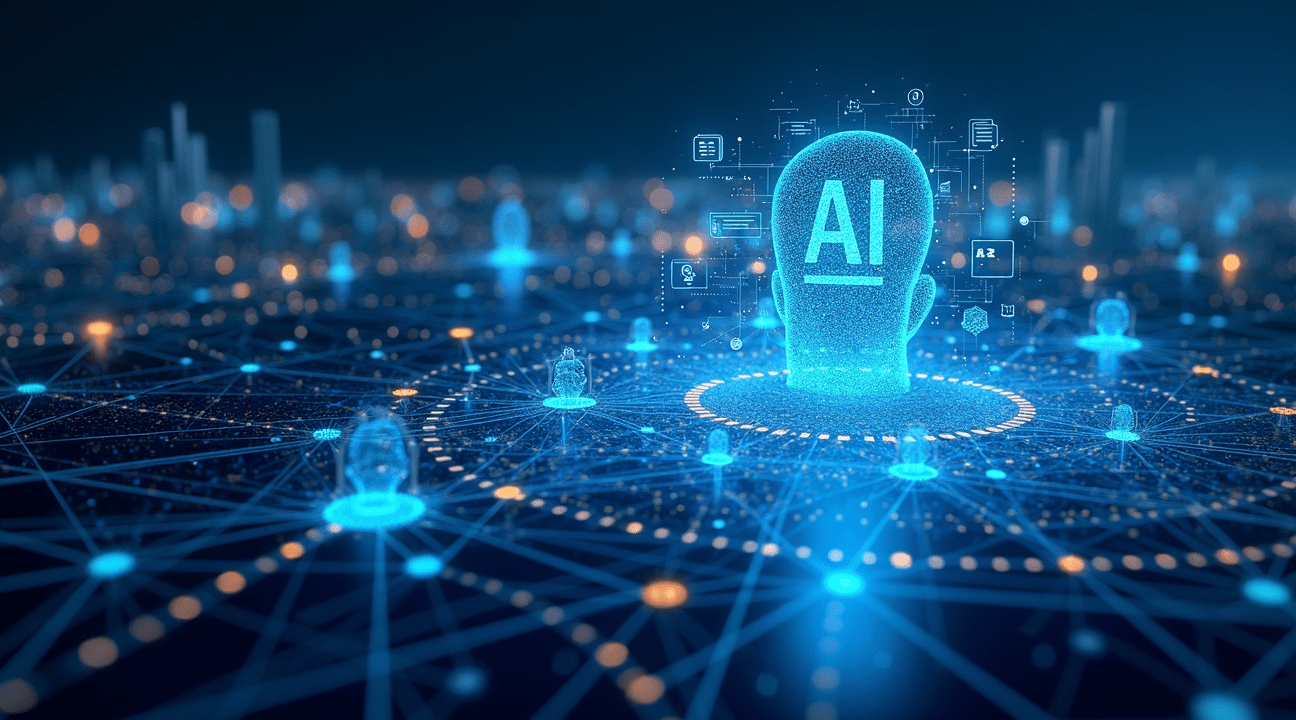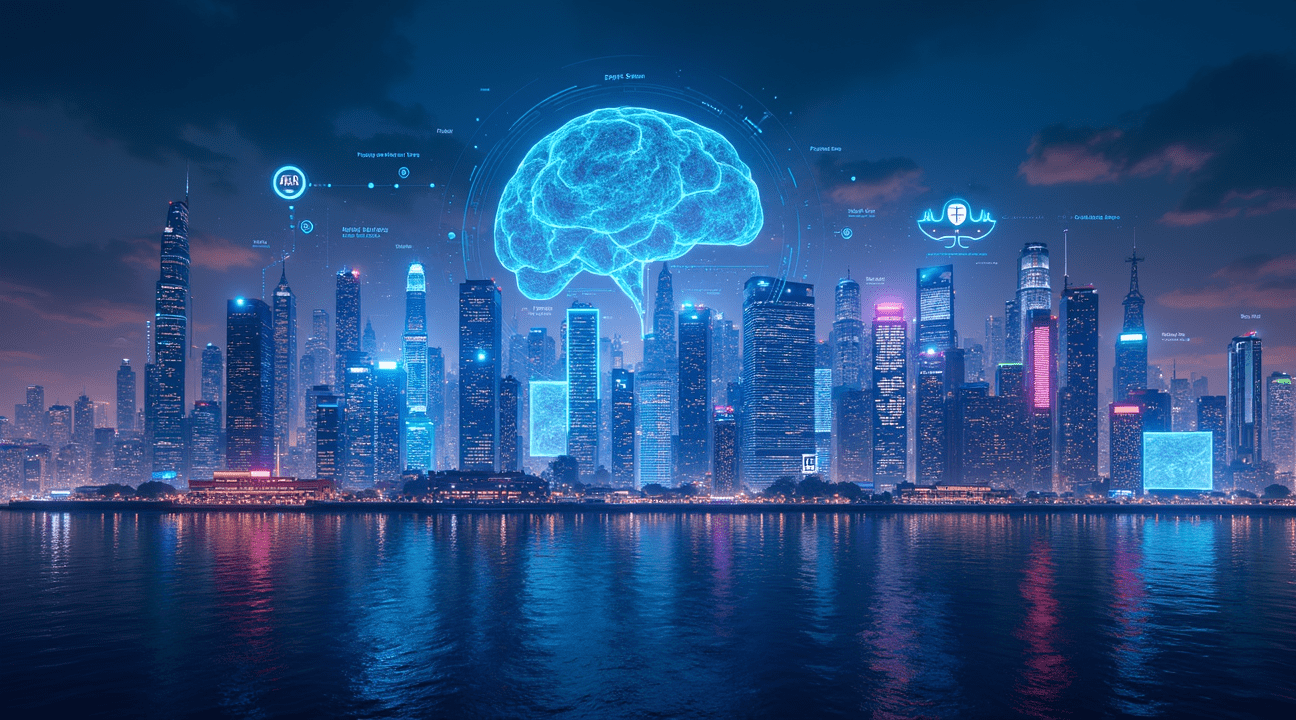Global private investment in AI generation reached $33.9 billion in 2024, marking an 18.7% increase from the previous year and demonstrating unprecedented investor confidence in artificial intelligence’s transformative potential.
This surge coincides with explosive market projections that anticipate generative AI will expand from approximately $37.89 billion in 2025 to an estimated $1,005.07 billion by 2034, propelled by a remarkable 44.20% compound annual growth rate (CAGR).
Key Takeaways
- Investment surge drives market expansion – The $33.9 billion in private investment reflects growing recognition of AI generation’s practical applications across industries such as entertainment, healthcare, education, and manufacturing.
- Massive adoption with monetization gap – Between 1.7 to 1.8 billion people around the world use AI tools. However, only 3% pay for premium services, presenting substantial opportunities for new and creative business models.
- Trillion-dollar economic impact potential – AI is expected to contribute up to $15.7 trillion to the global economy by 2030. Furthermore, the total AI market is projected to hit $3.68 trillion by 2034.
- Enterprise integration accelerating – More than 78% of organizations have adopted AI technologies. Leading companies, such as Netflix, are generating over $1 billion annually through AI-driven recommendation systems.
- Regulatory challenges alongside growth – While economic prospects remain immense, the AI sector must navigate complex regulatory landscapes and ethical dilemmas, prompting a need for balanced and thoughtful governance.
Global Private Investment in AI Generation Surges to $33.9 Billion in 2024
I’ve witnessed an extraordinary transformation in the AI generation landscape, with global private investment reaching an impressive $33.9 billion in 2024. This represents a substantial 18.7% increase from 2023, signaling unprecedented confidence from investors across the technology sector. The surge reflects a fundamental shift in how businesses and developers view the potential of artificial intelligence to revolutionize content creation.
Market Projections Show Explosive Growth Trajectory
The generative AI market demonstrates remarkable momentum, with projections indicating growth to approximately $37.89 billion by 2025. What makes these numbers particularly striking is the projected expansion to about $1,005.07 billion by 2034, driven by an exceptional compound annual growth rate (CAGR) of 44.20% from 2025 to 2034. These figures underscore the transformative impact that artificial intelligence continues to have across industries.
AI generation encompasses technologies that create entirely new content using artificial intelligence systems. Unlike traditional AI that analyzes existing data, these systems produce original text, images, music, and even video content from scratch. Users input prompts or parameters, and the AI responds with creative outputs that didn’t previously exist. Generative AI represents a focused subset of this broader category, specifically designed to produce novel and original content that often matches or exceeds human-created material in quality and creativity.
The investment surge reflects growing recognition of generative AI’s practical applications across multiple sectors. Companies are deploying these technologies to streamline content production, enhance customer experiences, and develop innovative products that would be impossible without AI assistance. From Google Bard’s popularity to breakthrough developments in video generation, the competitive landscape continues to expand rapidly.
Major technology corporations are driving significant portions of this investment wave. Microsoft and Google have committed billions to AI research and development, while startups focused on specialized generative applications attract substantial venture capital funding. The democratization of AI tools has created opportunities for companies of all sizes to leverage these capabilities, further fueling market expansion.
Recent innovations demonstrate the technology’s advancing sophistication. OpenAI’s Sora generates videos from text prompts, showcasing how AI generation extends beyond static content to dynamic media creation. Meanwhile, Apple is testing Apple GPT as a potential competitor in the generative AI space, indicating that even traditionally hardware-focused companies recognize the strategic importance of this technology.
The astronomical growth projections stem from generative AI’s proven ability to reduce production costs while increasing output quality and speed. Businesses report significant efficiency gains when implementing these tools for content creation, code generation, and problem-solving applications. Early adopters have demonstrated measurable returns on investment, encouraging broader market adoption and continued funding flows.
Key Sectors Poised for AI Integration
Industry experts note that current investment levels likely represent only the beginning of a much larger trend. As AI generation becomes more sophisticated and accessible, applications will expand into sectors that haven’t yet fully embraced the technology. Healthcare, education, entertainment, and manufacturing industries show particular promise for integrating generative AI solutions.
- Healthcare: AI-generated diagnostic tools and virtual health assistants
- Education: Personalized AI tutors and automated content creation
- Entertainment: Scriptwriting, video generation, and music composition
- Manufacturing: AI-designed prototypes and process optimization
Ethical Considerations in Rapid Advancement
However, the rapid growth also raises important considerations about responsible development and deployment. James Cameron’s warnings about AI emergence remind us that technological advancement must proceed thoughtfully. Investors and developers increasingly recognize the need to balance innovation with ethical considerations and safety measures.
The $33.9 billion investment milestone marks a pivotal moment in AI generation development. With such substantial financial backing, the technology will likely achieve new capabilities and applications that seem impossible today. Organizations considering AI generation adoption should evaluate their readiness now, as competitive advantages may depend on early and strategic implementation of these powerful tools.
AI Adoption Reaches 1.8 Billion Users Worldwide
The scale of AI adoption has reached unprecedented levels, with between 1.7 and 1.8 billion people now using various AI tools globally. This massive user base represents one of the fastest technology adoptions in human history, surpassing even the early growth rates of smartphones and social media platforms.
Daily engagement patterns reveal particularly strong commitment to AI technology. Between 500 and 600 million users interact with AI tools on a daily basis, demonstrating that these technologies have moved beyond experimental curiosity to become integral parts of people’s workflows and personal activities. In the United States alone, 61% of adults reported using AI within the past six months, showing remarkable penetration across demographic groups.
Enterprise Integration Drives Business Transformation
Organizations have embraced AI at an exceptional rate, with more than 78% implementing some form of artificial intelligence technology. This widespread integration spans diverse business sectors, from healthcare and finance to manufacturing and retail. Companies are leveraging artificial intelligence to streamline operations, enhance customer experiences, and gain competitive advantages in their respective markets.
The enterprise adoption rate significantly exceeds consumer premium subscriptions, creating an interesting dynamic in the AI ecosystem. While businesses readily invest in AI solutions for operational efficiency, individual users remain more cautious about paid premium services. This disparity highlights different value perceptions and use cases between personal and professional AI applications.
The Monetization Challenge Creates Market Opportunities
Despite the massive user base, only about 3% of users currently pay for premium AI services. This significant monetization gap presents both challenges and opportunities for AI companies and developers. The low conversion rate suggests that current premium offerings may not align with user needs or perceived value propositions.
Smart businesses can capitalize on this gap by developing innovative monetization strategies. Companies like Google Bard and other AI platforms are experimenting with different approaches to bridge this divide. Successful models might include:
- Freemium structures with compelling premium features
- Enterprise-focused solutions tailored to industry-specific needs
- Specialized tools that address niche professional applications
The disconnect between usage and payment patterns indicates untapped potential for companies willing to innovate beyond traditional subscription models. Organizations that can create genuine value propositions matching user behaviors and preferences will likely capture significant market share as the industry matures. Tech giants like Microsoft and Google continue investing heavily in AI development, recognizing the long-term revenue potential hidden within these adoption statistics.
This massive adoption foundation provides a solid platform for future growth and monetization innovations across the AI industry.
AI Generation Powers Billion-Dollar Business Applications
AI generation technologies have transformed how companies operate across entertainment, education, and marketing sectors. These powerful systems create automated content, deliver personalized recommendations, and generate data-driven insights that drive substantial revenue growth.
Netflix exemplifies this transformation through its sophisticated AI recommendation engine, which generates approximately $1 billion in annual revenue. The streaming giant uses machine learning algorithms to analyze viewing patterns, preferences, and user behavior, creating personalized content suggestions that keep subscribers engaged longer. This level of customization wouldn’t be possible without AI generation systems working continuously behind the scenes.
Industry Applications Driving Innovation
Different sectors harness AI generation capabilities to solve unique challenges and create competitive advantages:
- Entertainment companies use AI to generate movie trailers, music compositions, and script suggestions, reducing production costs while maintaining creative quality
- Educational platforms employ AI to create personalized learning paths, adaptive assessments, and customized study materials that adjust to individual student progress
- Marketing teams leverage AI for automated ad copy creation, social media content generation, and customer segmentation strategies that improve campaign performance
- E-commerce platforms utilize AI to generate product descriptions, personalized shopping experiences, and dynamic pricing strategies
Financial institutions have also embraced these technologies for fraud detection, risk assessment, and algorithmic trading. AI competitors continue pushing boundaries, creating more sophisticated generation capabilities that expand business applications.
The economic impact extends beyond individual companies. AI generation supports efficiency by automating repetitive tasks that previously required human intervention. Content creators can now produce draft materials in minutes rather than hours, while marketers generate multiple campaign variations simultaneously for testing purposes.
Video generation from text represents another breakthrough application, enabling businesses to create promotional content without expensive production teams. This democratization of content creation allows smaller companies to compete with larger corporations on visual storytelling.
Healthcare organizations employ AI generation for medical imaging analysis, drug discovery simulations, and patient care optimization. Manufacturing companies use these systems for predictive maintenance scheduling, quality control automation, and supply chain optimization.
The versatility of AI generation technologies continues expanding as companies discover new applications. From generating financial reports to creating virtual customer service representatives, these tools have become essential infrastructure for modern business operations. Organizations that successfully integrate AI generation capabilities often see improved productivity, reduced operational costs, and enhanced customer satisfaction scores.

The Global AI Market Set to Reach $3.68 Trillion by 2034
I’ve witnessed firsthand how artificial intelligence has transformed from a niche technology concept into the cornerstone of global economic growth. The numbers speak volumes about this transformation: the global AI market is projected to explode from $638.23 billion in 2025 to an astronomical $3,680.47 billion by 2034. This represents a compound annual growth rate (CAGR) of 19.20%, showcasing the accelerated adoption of artificial intelligence technologies across industries worldwide.
The momentum behind this growth isn’t just about flashy consumer applications or viral AI chatbots. Companies across every sector are integrating AI solutions into their core operations, from manufacturing and healthcare to finance and retail. Each implementation drives demand higher, creating a compounding effect that fuels the market’s explosive trajectory.
United States Leading the AI Revolution
Within this global surge, the United States stands as the undisputed leader, with its AI market forecasted to climb from $146.09 billion in 2024 to $851.46 billion by 2034. The slightly higher CAGR of 19.33% in the U.S. market reflects several key advantages that position America at the forefront of AI development.
Government policies have created an environment where AI innovation thrives. Federal initiatives provide funding, reduce regulatory barriers, and encourage research partnerships between universities and private companies. This supportive framework has attracted billions in venture capital investment, enabling startups to scale rapidly while established corporations expand their AI capabilities.
The concentration of major technology companies in the United States amplifies this growth. Companies like OpenAI, Google, and Microsoft continue to push boundaries with breakthrough innovations. OpenAI’s Sora represents just one example of how these companies are expanding AI capabilities beyond text generation into video creation. Meanwhile, Google’s Bard demonstrates the intense competition driving rapid advancement in AI technologies.
Competition between tech giants has accelerated development timelines dramatically. Microsoft and Google invest billions annually in AI research, while Apple tests its own GPT to compete in the generative AI space. This rivalry ensures continuous innovation and keeps the United States ahead of international competitors.
The ripple effects of this market growth extend far beyond technology companies themselves. Traditional industries are experiencing fundamental shifts as AI adoption becomes essential for competitiveness.
Examples of AI transformation include:
- Manufacturing companies using AI for predictive maintenance to reduce downtime and operational costs
- Healthcare providers implementing AI diagnostics that improve patient outcomes while lowering costs
- Financial institutions deploying AI-powered fraud detection systems to protect consumers and mitigate losses
Small and medium-sized businesses are also driving market expansion as AI tools become more accessible and affordable. Cloud-based AI services allow companies of any size to leverage sophisticated algorithms without massive upfront investments. This democratization of AI technology broadens the market base significantly.
The projected growth reflects changing consumer expectations as well. Customers now expect personalized experiences, intelligent recommendations, and seamless interactions across digital platforms. Meeting these expectations requires AI integration, pushing more companies to adopt these technologies regardless of their industry or size.
Investment patterns indicate strong confidence in sustained growth. Venture capital firms continue pouring money into AI startups, while public companies allocate larger portions of their budgets to AI initiatives. This capital influx accelerates development cycles and brings new solutions to market faster than ever before.
The trajectory from hundreds of billions to trillions of dollars signals AI’s transition from an emerging technology to a fundamental economic force. Even skeptics like James Cameron acknowledge AI’s transformative power, though they raise important questions about its implications.
As we approach 2034, the convergence of technological advancement, supportive policies, and market demand creates an environment where AI growth appears inevitable. The $3.68 trillion global market projection represents just the beginning of AI’s economic impact.

AI Could Add $15.7 Trillion to Global Economy Despite Regulatory Hurdles
Artificial intelligence technologies are poised to deliver unprecedented economic benefits. According to projections, AI could contribute up to $15.7 trillion to the global economy by 2030. This massive economic impact stems primarily from productivity gains and operational enhancements across various industries.
Generative AI Leading Economic Transformation
Generative AI stands at the forefront of this economic revolution. These advanced systems offer remarkable potential for boosting efficiency across multiple business functions. Companies are already leveraging generative AI to streamline operations, automate complex tasks, and create innovative solutions that weren’t possible just a few years ago.
The technology’s ability to process vast amounts of data and generate human-like content makes it particularly valuable for transforming traditional workflows. From Apple’s AI initiatives to groundbreaking developments like OpenAI’s Sora video generation, the practical applications continue expanding rapidly.
https://www.youtube.com/watch?v=dOxftDOA-BM
Regulatory Challenges and Ethical Considerations
Despite its enormous potential, the AI sector confronts significant regulatory hurdles. Ethics and governance frameworks remain underdeveloped compared to the technology’s rapid advancement. These challenges create uncertainty for businesses and investors who want to capitalize on AI’s benefits while maintaining compliance with emerging regulations.
Ethical development practices have become central concerns for AI companies. Responsible deployment requires careful consideration of potential biases, privacy implications, and societal impacts. Major tech companies like Microsoft and Google are investing heavily in ethical AI frameworks to address these concerns.
The competitive landscape continues intensifying as companies race to develop superior AI capabilities. Google Bard’s rising popularity exemplifies how quickly market dynamics can shift in this space. However, even prominent figures in technology and entertainment, including James Cameron, have voiced concerns about AI’s rapid development.
Striking an effective balance between innovation and ethical governance will determine whether the AI sector achieves sustainable growth. Companies that prioritize responsible development while maintaining competitive advantage are likely to capture the largest share of AI’s projected $15.7 trillion economic contribution. Success requires comprehensive strategies that address both technological advancement and regulatory compliance from the outset.

Economic Impact and Long-Term Market Projections
The AI generation market’s explosive growth demonstrates its capacity to reshape entire industries through revolutionary content creation capabilities. Companies across sectors are discovering how artificial intelligence is paving the way for unprecedented efficiency gains and creative possibilities. This technological shift isn’t just changing how businesses operate—it’s fundamentally altering their economic models and competitive landscapes.
Market Growth Trajectory and Investment Potential
Generative AI’s high projected compound annual growth rate reflects investor confidence and market demand for intelligent automation solutions. Financial analysts consistently forecast double-digit growth rates as enterprises integrate AI generation tools into their workflows. The technology’s ability to produce high-quality content at scale attracts significant venture capital and corporate investment, creating a self-reinforcing cycle of innovation and market expansion.
Industries experiencing the most dramatic economic impact include:
- Media production – AI assists in scripting, editing, and post-production.
- Software development – Automating code generation and system testing.
- Marketing – Content personalization and strategy automation.
- Customer service – AI chatbots and virtual assistants improving responsiveness.
Content creators now leverage AI to produce initial drafts, generate ideas, and streamline production timelines. Software companies integrate generative capabilities into existing platforms, while service providers offer AI-powered solutions that enhance customer experiences and reduce operational costs.
Strategic Considerations for Long-Term Adoption
Despite the optimistic projections, successful AI generation implementation requires careful planning and risk management. Organizations must balance automation benefits with workforce considerations, ensuring employees can adapt to new AI-enhanced roles rather than being displaced. The most successful companies view AI generation as a collaborative tool that amplifies human creativity rather than replacing it entirely.
Market leaders are already establishing frameworks for responsible AI use, addressing concerns about content authenticity, intellectual property rights, and ethical implementation. These considerations become increasingly important as video generation from text and other advanced capabilities enter mainstream adoption.
The competitive landscape continues evolving as major tech companies like Google and OpenAI compete for market dominance. This competition drives rapid innovation cycles, making AI generation tools more accessible and affordable for businesses of all sizes. As Apple tests its AI capabilities, the market expects further democratization of generative technology.
Economic benefits extend beyond direct cost savings to include:
- New revenue streams through AI-generated products and services.
- Improved customer engagement via personalization and automation.
- Accelerated product development cycles using AI-driven innovation.
Companies that strategically implement AI generation tools position themselves for sustained competitive advantages in an increasingly digital marketplace.
Sources:
Exploding Topics – AI Statistics
Meetanshi – Generative AI Statistics
Menlo Ventures – 2025: The State of Consumer AI
Precedence Research – Artificial Intelligence Market
National University – AI Statistics and Trends
Teneo – AI Statistics and Trends 2025
Vena Solutions – AI Statistics


